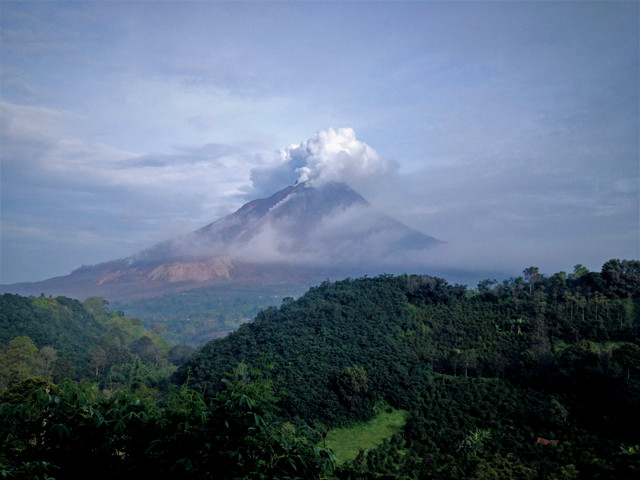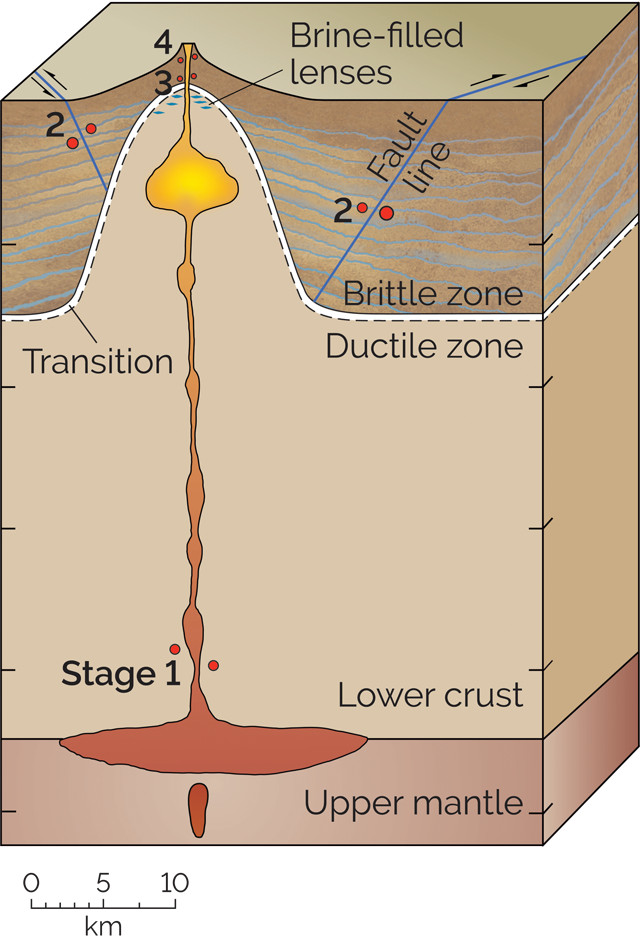
by Mary Caperton Morton Wednesday, November 15, 2017

Sinabung Volcano in Sumatra, Indonesia, began erupting in 2010 after a 400-year hiatus, with major eruptions again in 2014 and 2016. Credit: Nekomong, CC BY-SA 4.0.
Earth is home to more than 1,500 potentially eruptive volcanoes on land, each with a unique character and history. Predicting when and how a particular volcano may erupt is notoriously difficult, in large part because each eruption is unique. Recent work tracking pre-eruptive seismic behavior beneath two dozen reawakened volcanoes has revealed a distinctive pattern that seismologists may be able to use to assess when — and how violently — a rumbling volcano could blow its top.
The trickiest eruptions to forecast are those from volcanoes that have not erupted in recent history. “Frequently active volcanoes are the ones that tend to get the most attention in terms of research and monitoring. The ones that have been quiet for 10 or 20 years, or longer, we know much less about,” says Wendy McCausland, a seismologist at the U.S. Geological Survey (USGS) in Vancouver, Wash., and one of the researchers involved in the new work.
To look for patterns in pre-eruptive seismic behavior, McCausland and Randall White, with USGS in Menlo Park, Calif., sought seismic data from reawakened stratovolcanoes all over the world. The big, potentially explosive — and thus dangerous — volcanoes found around the Pacific Ring of Fire are stratovolcanoes, for example, White says. “The longer they have been quiet, the bigger the eruptions tend to be.”
Installing seismic, GPS and other monitoring equipment on active volcanoes is logistically difficult and potentially dangerous, meaning not all volcanoes are as thoroughly monitored as seismologists would hope. So, McCausland and White developed a bare bones approach to monitoring that requires a minimal amount of equipment: just three seismic stations positioned within a kilometer or two of a volcano. Using equipment installed by the USGS’s international Volcano Disaster Assistance Program in recent decades and drawing on data gathered as far back as the 1980s by USGS and various local monitoring agencies around the world, the team tracked pre-eruption seismicity for 32 eruptions at 24 stratovolcanoes worldwide. Despite the varying geologic settings and eruptive histories of the different volcanoes, they found that most of the eruptions were preceded by a common pattern of four distinct seismic stages.

Research by U.S. Geological Survey scientists has elucidated a four-stage pattern of seismicity that occurs prior to many eruptions at long-dormant volcanoes. Bold numbers refer to the successive stages and show the approximate depths of related seismicity. Credit: Lisa Faust, USGS.
“At first, it seems like every volcano is different, but once you see enough eruptions, certain similarities stand out,” White says. In the eruptions they studied, in stage 1, low-frequency tremors occurred deep beneath the volcano, representing magma intruding into a shallower reservoir. This stage often started weeks to months before an eruption, and would tend to be missed at unmonitored volcanoes. Stage 2 represents the first outward signs that a long-quiet volcano may erupt, including earthquakes up to magnitude 3 and steam-driven phreatic explosions. Most of the volcanoes they studied — up to 97 percent — began stage 2 about two weeks prior to the main eruption.
In stage 3, earthquakes increased in frequency and magnitude, with the quakes originating from a shallower source as magma moved higher through a volcano’s plumbing system. In stage 4, repetitive earthquakes, increasingly sustained tremors and dome-building — sometimes visible with the naked eye — occurred. McCausland and White reported their findings for the 24 volcanoes at a meeting of the International Association of Volcanology and Chemistry of the Earth’s Interior in August in Portland, Ore. In April, with additional colleagues, they also reported findings specifically for eruptions in 2014 at Indonesia’s Sinabung Volcano in a special issue of the Journal of Volcanology and Geothermal Research. They think these results can be extrapolated to most long-quiet stratovolcanoes.
Previously, some of the stages had been recognized by seismologists during individual eruptions, but nobody had tracked all of the stages at a wide array of volcanoes, White says. The stages represent magma progressively moving up through the inner workings of a volcano. Since the volcanoes White and McCausland studied were long quiet — and sometimes considered dormant — the magma had to pioneer a route from a deep subterranean chamber, up through layers of rock, before it could erupt at the surface.
“[McCausland and White] have identified similarities in behavior, regardless of what the volcano looks like,” says Christopher Kilburn, a geophysicist at University College London, who was not involved in the new study. “There are simple constraints that all magma has to overcome in order to erupt: The magma is deep underground and it needs to get aboveground. Creating that pathway to the surface is a common feature of all volcanoes reawakening after a long repose.”
White and McCausland observed that not all volcanoes that begin stage 1 proceed to a full eruption. Many stop before reaching stage 2 or 3. But if a volcano proceeds from stage 1 to 2 to 3 in a matter of weeks to months, it’s likely it will proceed to a full eruption. The vigor of the earthquakes produced in stage 2 also provides some clues as to the size of the eventual eruption, White says. “At stage 2, the total energy of the earthquakes correlates to the total volume of magma that is intruding up into the upper reservoir. If there is a lot of energy, that means there is a large volume of magma with the potential for a large eruption.” If the sequence then progresses to stage 3 and stage 4, the odds are extremely high — over 95 percent, they found — that an eruption will occur within days. Additional monitoring of gas emissions and ground deformation, for example, can also help refine eruption forecasts, White says.
Basic monitoring systems and predictable patterns of behavior may help local agencies make decisions about whether to evacuate people living near a volcano, especially in places like Indonesia, which has more than 80 potentially active volcanoes to monitor, McCausland says. Sinabung, for example, had been quiet for more than 400 years, and residents had little notion of what to expect from an eruption. “This four-stage process gave us a very tangible way to communicate the danger to the public,” McCausland says, “and to provide local authorities with the information they needed to make the decision to evacuate thousands of people.”
© 2008-2021. All rights reserved. Any copying, redistribution or retransmission of any of the contents of this service without the expressed written permission of the American Geosciences Institute is expressly prohibited. Click here for all copyright requests.